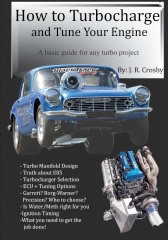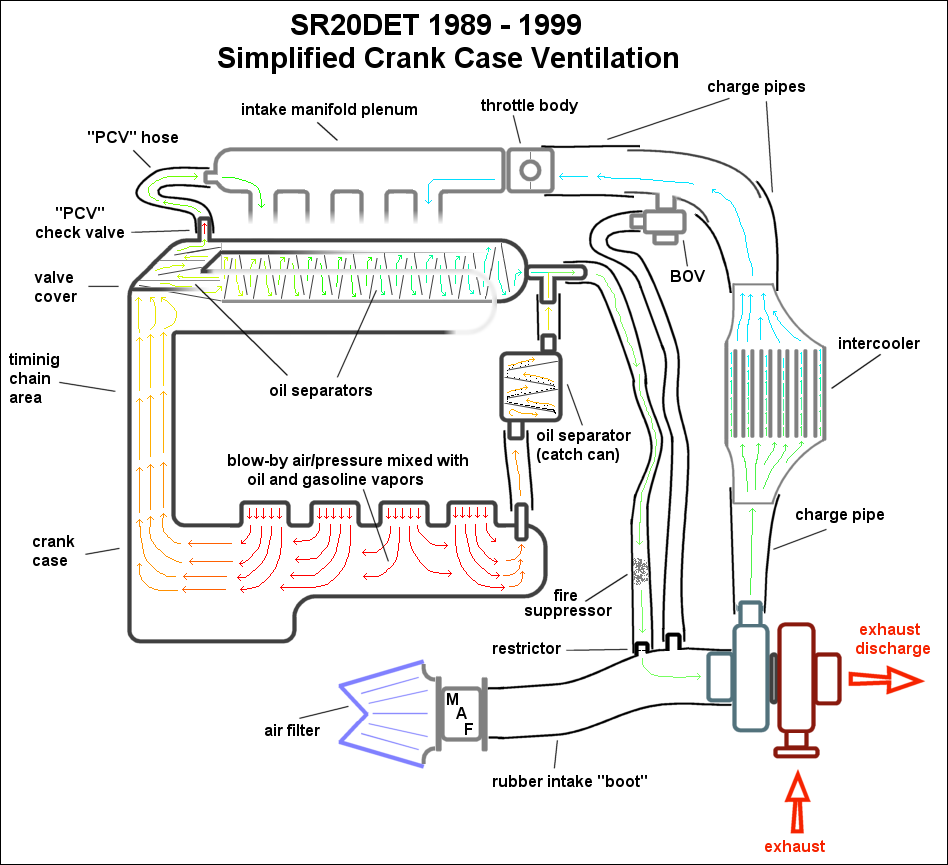| What's Hot! | Products/ Tools | EFI Tuning | Basic Tuning | Advanced Tuning | Chassis Tuning | Advertise with us |
Turbocharged Engine Crank Case Ventilation
Contributed By: B. Fenner
While this article will use a Nissan SR20 engine as a reference, the information found here can be applied to all motors.
Since this is the turbocharged edition of the crank case ventilation thread, I think it needs a few things. Maybe a front mount intercooler, some bigger tires, possibly an upgraded fuel pump. I'll see if I can get someone on that. In the mean time, let me start off by saying this article is a companion article to the Naturally Aspirated edition Crank Case Ventilation article. You are required to read that thread first, as it has most of the information you need to know in it, and I won't be going over that stuff again here. Go read that thread first, then come back here.......
Welcome back from reading the naturally aspirated version of the crank case ventilation system. You did read the naturally aspirated edition, right? Yes? Okay good.
The main difference between a boosted engine and a naturally aspirated engine for these discussions is that in a boosted application the intake tract can be pressurized above atmospheric pressure. This means that where you used to have zero net pressure, you will have some positive pressure in the intake system. This changes the options of where you can vent the crank case to. You'll want to find new sources of vacuum, and you'll want to make sure you don't accidentally let boost pressure enter the crank case and pressurize it.
There is one more difference that you should be aware of. Boosted engines tend to have much higher cylinder pressures than naturally aspirated engines. This produces more power obviously, but it also produces more "blow-by" which you will recall from the naturally aspirated edition of this topic is something we'd like to limit and control. These two things conspire to make ventilating the crankcase of a turbocharged (or supercharged) engine more difficult and more important than on a naturally aspirated engine. Most people don't even bother messing with the crankcase ventilation system on naturally aspirated engines and only wait until they turbocharge the engine to get serious about the system, because now the ante has been raised. We should start off with a diagram of the factory positive crankcase ventilation system as seen on most common SR20DET engines. (click for larger image)
Remember that to set up a proper system you will need a catchcan, also called an oil seperator. Some great examples are found below:
ATTENTION READER:
If you enjoyed the information and article you just read be sure to check out our newly released book with even more exciting photo's and information:How to Turbocharge and Tune your Engine

Want to know more about your particular Make and Model vehicle? All of these vehicles are covered in the tech, maintenance and repair articles found above. Enginebasics is the wiki or wikipedia of car part, repair, how to and tuning information. Let us be the class 101 for your automotive learning.
| Ford | General Motors GM | Pontiac | Jaguar | Land Rover | Nissan |
| Toyota | Honda | Lexus | Acura | Lotus | Scion |
| Infinity | BMW | Mercedes | Mitsubishi | Ferrari | Maserati |
| Lamborghini | Volks Wagen VW | Saab | Audi | Hyundai | Kia |
| Subaru | Mazda | Chevy | Volvo | Caddilac | Dodge |
| Chrylser | Daewoo | Porsche | Mercury | Freightliner | MG |
Individual Models
| Ford Mustang | Mitsubishi Eclipse | Mitsubishi Evo | Subaru WRX / STI | Dodge Viper | Chevrolet Corvette |
| Nissan Skyline | Honda S2000 | Nissan 350z | Toyota Supra | Chevy Camaro | Lotus Elise Exige |
| Honda Civic | VW Golf | Dodge SRT-4 | Eagle Talon | Acura Integra | BMW M3 |
| Nissan 240sx | Porsche 911 | Acura NSX | Honda Accord | Toyota Camry | Toyota MR2 |
| VW R32 | Dodge Truck | Mazda Rx7 | VW Jetta | Sand Buggy | Nissan Sentra |
For the latest Automotive news and stories visit the websites below |
Our feature Build: An AWD V6 Civic





